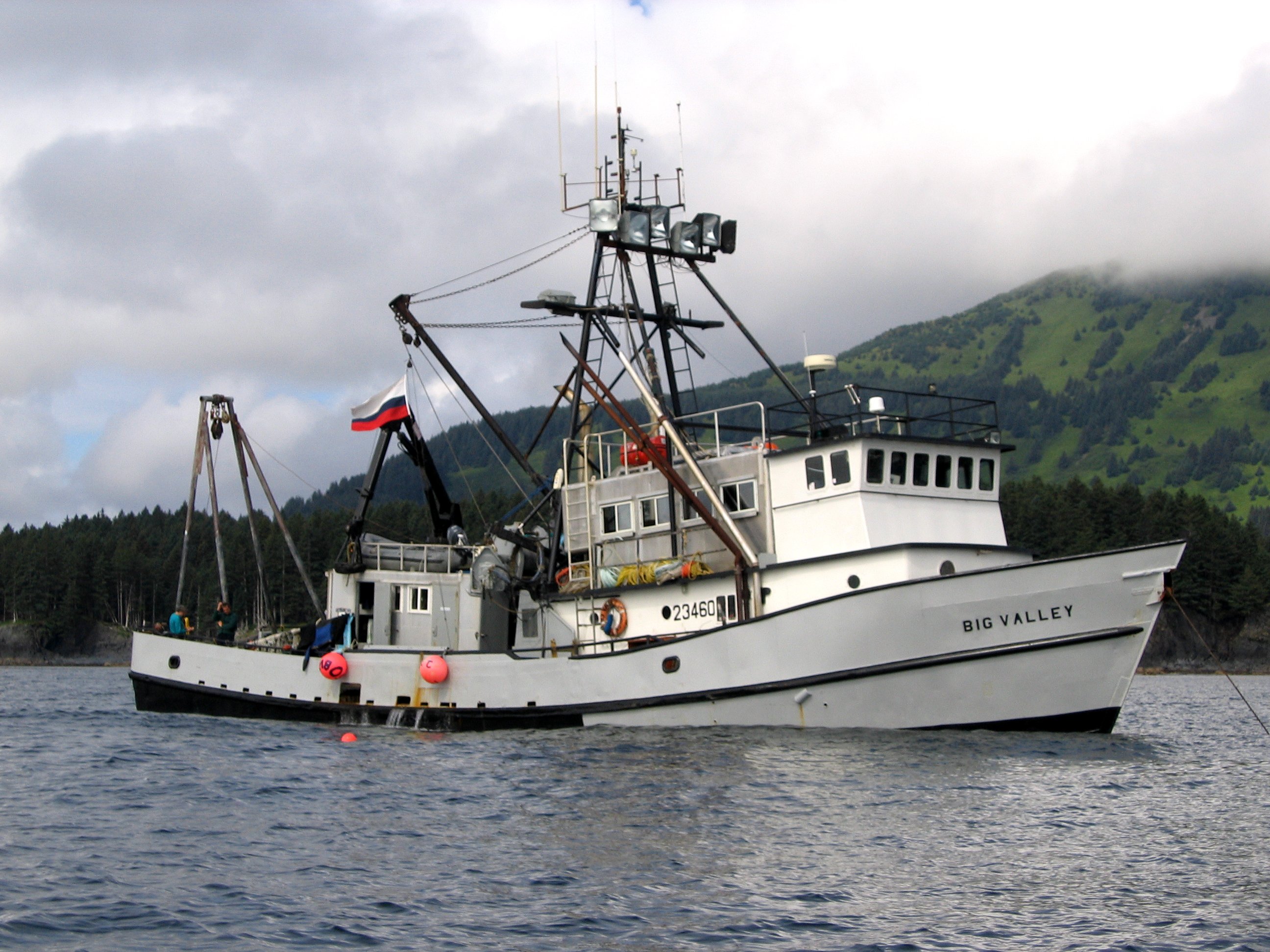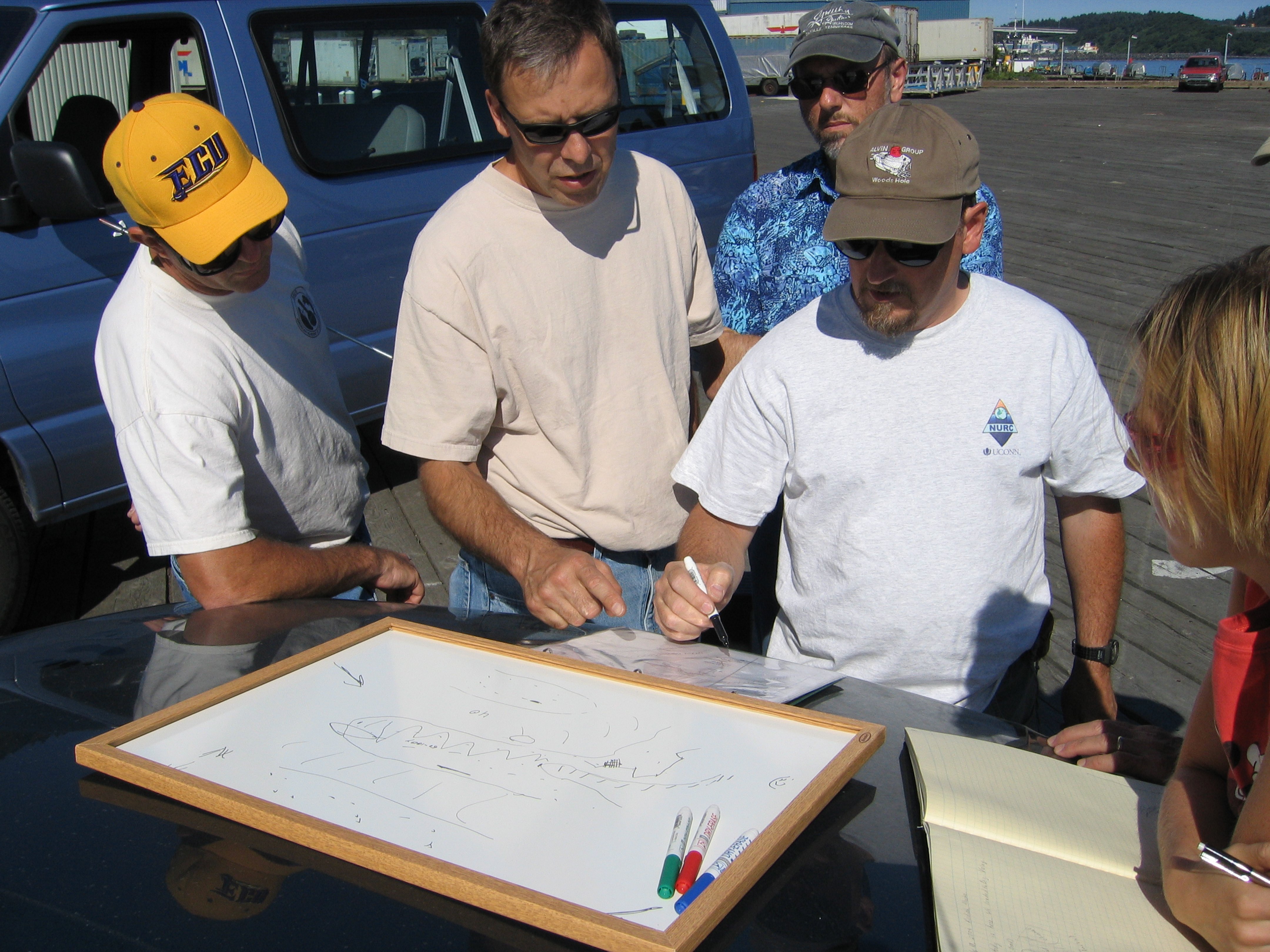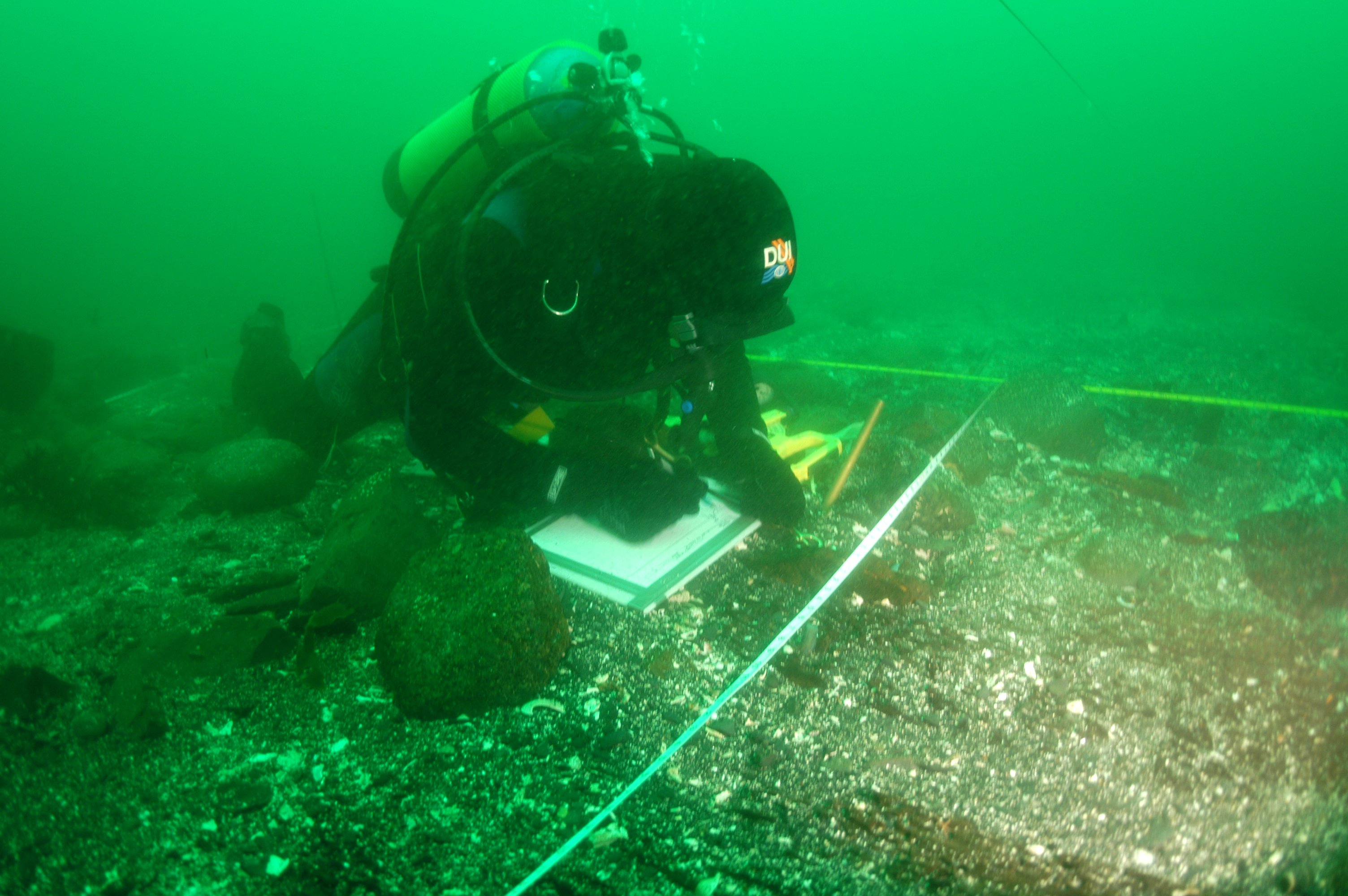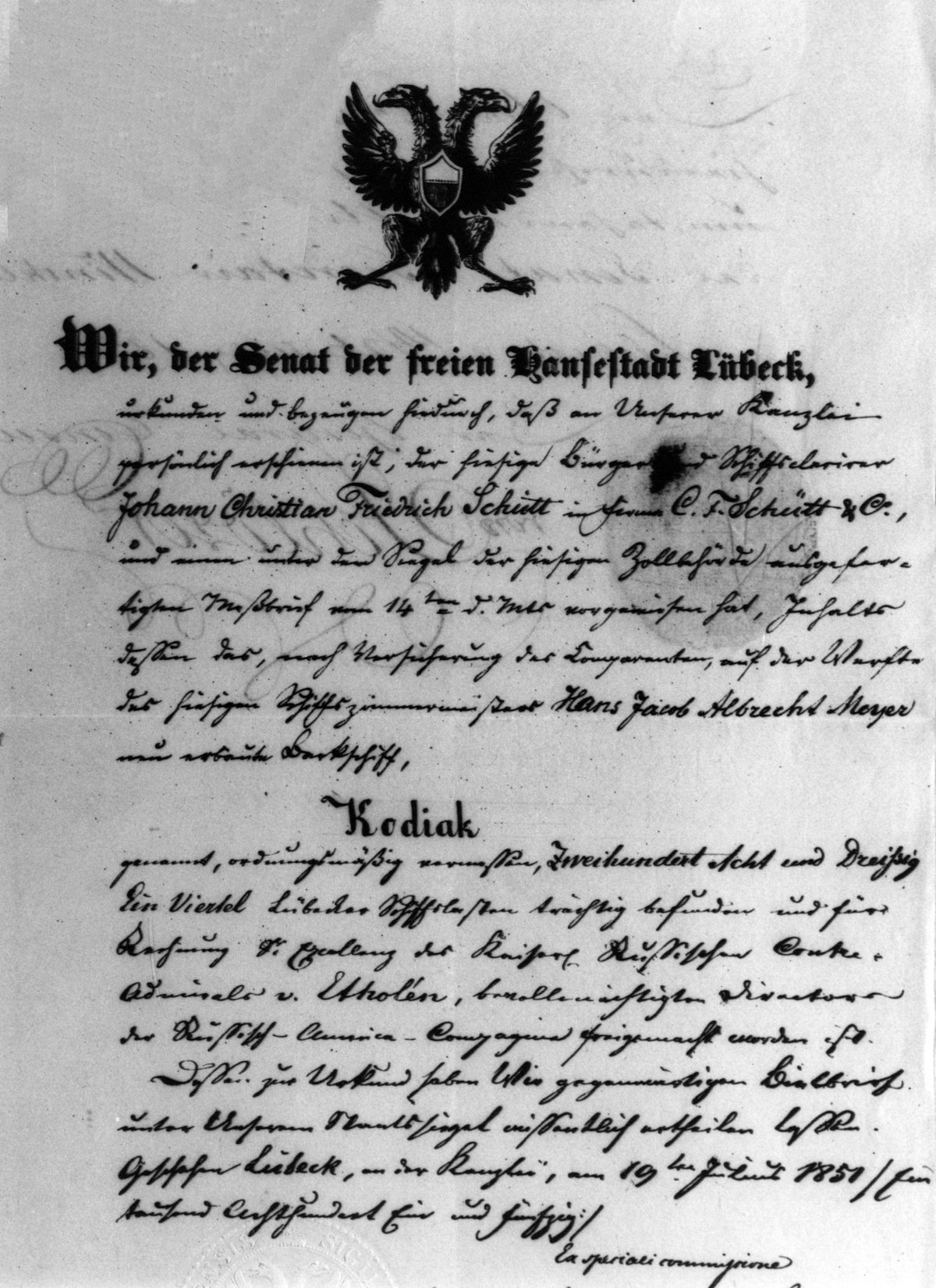The Kad'yak Project

investigations. Photo by Tane Casserley
The Kad'yak was a Russian three-masted wooden bark that sank off Spruce Island (Kodiak Archipelago) in 1860. The investigation of the wreck site in 2004 represents the first substantive underwater archaeology project to be conducted in the State of Alaska.
-
The Discovery of the Kad'yak
-
The Kad'yak's discovery was the culmination of years of work by different researchers. Research on the bark was initiated after the translation of P.A. Tikhmenev's History of Russian America in 1976. This prompted Alaskan archaeologist Mike Yarborough's 20 year search for materials related to the ship. One document which attracted his attention was a copy of the captain's survey notes held in the U.S. National Archives. The document was subsequently translated by Dr. Kathy Arndt at the University of Alaska. Yarborough sent the translation to Dr. Brad Stevens of the National Marine Fisheries Service, in Kodiak, who was fascinated by the story. In 2001 he explored the waters near Spruce Island with a remotely operated vehicle, but did not find any wreckage. Then in 2002, Dr. Stevens collaborated with Dave McMahan, senior archaeologist with the State of Alaska Office of History and Archaeology, and Dr. Timothy Runyan, Director of the Maritime Studies Department at East Carolina University. Collectively, they submitted a grant proposal to the NOAA Office of Ocean Exploration, to investigate the Kad'yak site.

Team members planning field operations. Photo by Tane Casserley In July 2003, Dr. Stevens obtained information from Dr. Lydia Black, a noted historian of Russian America, which helped him to decipher bearings recorded by the Kad'yak's last captain, Illarion Arkhimandritof. With this new evidence, Dr. Stevens organized a group of volunteer divers to search for the Kad'yak site in late July 2003, with support from the Kodiak Historical Society. Using a magnetometer, searching with scuba divers, and a good deal of luck, the wreckage was located.
Maritime archaeologist Jenya Anichenko at the wreck site. Photo by Tane Casserley The Kad'yak lies on State of Alaska submerged lands, and is the property of the State of Alaska. The site is protected by the Alaska Historic Preservation Act (AS 41.35), which prohibits removal of artifacts or disturbance of the site except under permit by authorized researchers.
Archaeologists measure the fluke of one of the Kad'yak anchors. Photo by Tane Casserley In February 2004, NOAA's Office of Ocean Exploration awarded a grant to East Carolina University for the purposes of investigating the Kad'yak site. Participants in the project included the Kodiak Maritime Museum, the Alutiiq Museum, the Baranov Museum, National Marine Fisheries Service, and the State of Alaska Department of Natural Resources. The main goals of the project were to record and document important historical and archaeological data, and make them available to specialists in the field as well as the general public. Historic research, including archival investigations, started in 2003 and fieldwork took place in July 2004.
-
-
Field Investigations and Project Results
-
The Kad'yak sank in Icon Bay, or Monk's Lagoon, on the eastern side of Spruce Island. Spruce Island itself is off the northeast coast of Kodiak Island, separated by less than a mile across the Ouzinkie Narrows. Icon Bay is a maze of rocky reefs and gravel channels with 10-cm high ripples. The outer margin of the bay is punctuated by narrow, vertical rock pinnacles, which extend upward for about 10m, and run southwest-northeast, generally parallel to the shoreline and depth contour. Between the pinnacles the bottom is rocky or covered with coarse sand and gravel.
The underwater environment often determines what parts of a shipwreck are preserved. Icon Bay faces the Gulf of Alaska and is exposed to waves, currents, and strong underwater surge. These elements have battered the site for over 140 years and the remains look very little like the original Kad'yak. Most of the bark's wooden structure has disappeared except for the parts buried under the sand. Cannon, anchors and other large metal artifacts, covered with marine growth, litter the bottom. Shifting sands within the bay periodically cover and uncover parts of the wreck.

Kad'yak wreck site. Photo by Tane Casserley The main goal of field work was to find out how much of the Kad'yak remains, by determining the site's boundaries and the extent of artifacts and ship structure. Archaeologists first inspected the site to determine the best way to map the vessel's remains without disturbing the shipwreck. Then a baseline was placed across the site to use as a reference for mapping. Archaeologists then took careful measurements of the site's exposed features and drew them on Mylar, a waterproof plastic sheet. The site was also carefully recorded with video and still cameras. The drawings were transferred to graph paper to make a very detailed map. A site map provides fundamental information on how the shipwreck is laid out by showing the distribution of artifacts and ship structure. It helps to determine the vessel's bow and stern orientation, functional living and working spaces, and how the natural environment has impacted the site since the sinking.
The Kad'yak site contained a wide variety of artifacts. Some of these are diagnostic and help identify the age of the vessel, its origin, and confirm the shipwreck's identity.

Archaeologists mapping Kad'yak hull remains. Photo by Tane Casserley The shipwreck is dispersed over two areas located roughly 40 m apart. The first area corresponds with the vessel's bow and midsection, and the second with the stern. The largest structural fragment is a section of the hull preserved under and around a ballast pile. Significant artifacts located in the vicinity include three wrought iron anchors and two cast iron cannon. Rudder mounting hardware was recovered from the stern concentration. The most significant artifact from the site is a cylindrical object with writing on one end – the hub of the ship's wheel. The well-preserved surface of the brass end cap bears the inscription Kad'yak in Russia's pre-revolutionary Cyrillic alphabet. The artifact, inscribed with the ship's name, allowed the team to positively identify the wreck.

Measuring location of wheel hub artifact. Photo by Tane Casserley All of the information collected during the project helps to reveal the story of the Kad'yak. To date, the Kad'yak is the only located Russian-American Company shipwreck. At the time of sinking, the she was provisioned for a three-month voyage and carried a cargo of ice for San Francisco. While the ice is long melted the ship and the belongings of the crew remain. The archaeological study of the vessel's material culture provides valuable information about the Kad'yak, her crew, and her role in the Russian American Company.
-
-
History of the Russian-American Company bark Kad'yak
-
By Jenya Anichenko
The Kad'yak, a wooden three-masted bark of 477 tons, was built by Hans Jacob Albrecht Meyer in the shipyard of Lübeck, Germany in 1851. She left the Baltic port of Kronshtadt for the North Pacific on August 7, 1851, and arrived at Novo-Archangelsk (Sitka) on May 7, 1852. The Kad'yak was a significant addition to the ocean-going fleet of the Russian-American Company, which at that time consisted of just ten vessels.

Certificate of Purchase for the bark Kad'yak. Lübeck Municipal Archives In subsequent years, the vessel was actively engaged in trade in North America, ranging from regular trips between Russian settlements in Alaska to trading voyages to Hawaii and California. The complement of the Kad'yak varied in size from twenty-five to thirty people and included a captain, two officers, one supercargo, two boatswains, thirteen sailors, and six to eight hands, usually Native Americans. Four to six cast iron cannons were carried aboard during some voyages. The vessel drew 14 feet of water, and had an average speed of about four and a half knots.
From 1857 onward, the Kad'yak's main destination was San Francisco, where the Russian-American Company carried on a profitable ice trade. Like many of their predecessors and descendants, Californian gold hunters liked their beer cold, and it did not take long for Russians to figure out the profitability of this new market. Before 1852 all the ice needed in San Francisco had been carried around Cape Horn, thus obtaining it in Alaska was significantly more cost-efficient. The ice was cut from lakes in Sitka and Woody Island (near Kodiak Island) and shipped to California. The original plan of supplying San Francisco with 1,200 tons of ice per year made the availability of appropriate vessels the key point to the success of the trade. Between 1857 and 1859 the Kad'yak called at the port of San Francisco six times. In addition to ice she brought furs, timber, salted fish and tallow candles. On her way back she carried flour, corned beef and other provision.
The Kad'yak left Sitka for the final time on February 27, 1860, to pick up 356 tons of ice at Kodiak. On putting to sea from Kodiak harbor on March 30, the vessel hit an uncharted rock in the proximity of Woody Island, and immediately filled with water. The captain, a Creole named Illarion Arkhimandritov, the officers and crew took to the ship's boats. The Kad'yak, kept afloat for three days by her cargo of ice, drifted towards Spruce Island and sank in Icon Bay (commonly known as Monk's Lagoon) on April 2, 1860. The mast of the ship protruded above the water forming the shape of a cross, visible from the shrine of Father Herman (later St. Herman) on the coast of Spruce Island, giving a metaphysical touch to the story of the vessel's misfortune. According to legend, the Kad'yak's captain failed to fulfill his promise to venerate relics of this famous monk in Kodiak cathedral prior to his departure from the island.
The officials of the Russian-American Company were, however, too busy to meditate over the symbolic meaning of the circumstances of the Kad'yak's wrecking. They were much more concerned about the damage the loss of the ship caused to the colonial trade, and with the prevention of further hazards which the newly discovered underwater rock might cause in this heavily navigated area. Anticipating the arrival of several company cargo ships, orders were given to keep a baidarka immediately next to the rock to warn all approaching vessels. Eventually red and blue buoys were placed near the hazard, which together with the lighthouse at the top of Baranov Castle in Sitka, were the only aids to navigation in Russian America.
In another effort to improve local navigation, the company manager appointed Captain Arkhimandritov to chart the coast of Spruce Island. Using three baidarkas and the help of six Aleuts, Arkhimndritov successfully accomplished this mission in the summer of 1860. The bearings he provided for the protruding mast of the Kad'yak is the last appearance the ship makes in the records of the Russian-American Company. The same bearings were used to help locate the shipwreck of the Kad'yak in July 2003, opening a new chapter in the history of the vessel.
-
